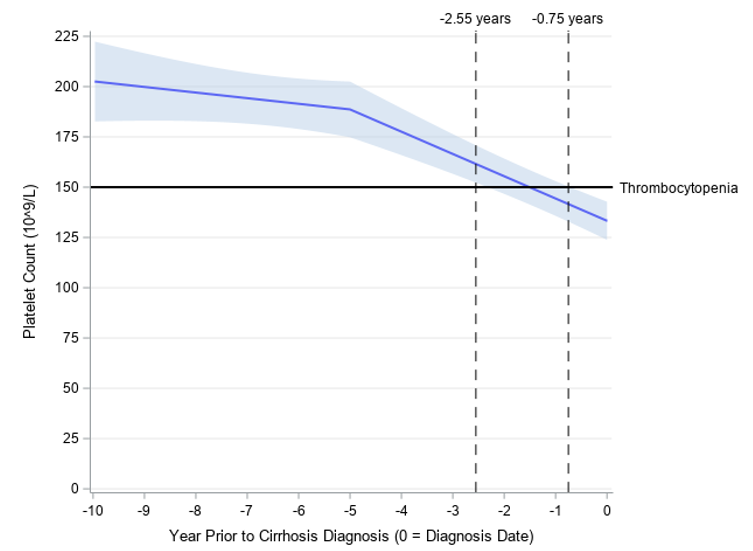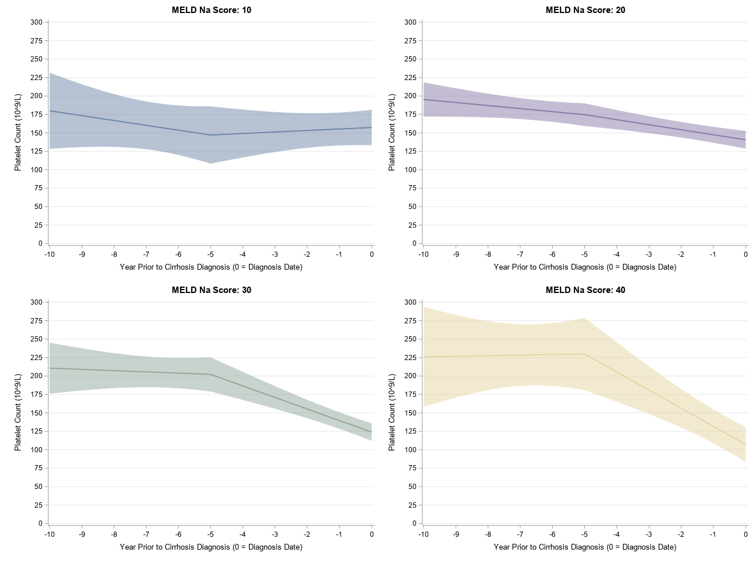Sunday Poster Session
Category: Liver
P1537 - Using Thrombocytopenia to Predict the Timing of the Onset of MASH Cirrhosis: A Retrospective Cohort Study
Sunday, October 26, 2025
3:30 PM - 7:00 PM PDT
Location: Exhibit Hall

Aditya Avula, DO
CHI Health Creighton University Medical Center
Omaha, NE
Presenting Author(s)
Aditya Avula, DO1, Eduardo A. Canto, BS2, Alex Schaedler, BS3, Bridget Hickey, BS3, Thomas Rees. Checketts, DO4, Ryan W. Walters, PhD1, William Reiche, DO2, Sandeep Mukherjee, MD1
1CHI Health Creighton University Medical Center, Omaha, NE; 2Creighton University Medical Center, Omaha, NE; 3Creighton University School of Medicine, Omaha, NE; 4Creighton University, Omaha, NE
Introduction: Early identification of patients at risk for cirrhosis is critical for improving long-term outcomes. While platelet-based scoring systems lack accuracy compared to imaging for diagnosis, they may still serve as early indicators. In this study, we examined the timing of thrombocytopenia in relation to cirrhosis onset to assess its potential as a risk screening tool.
Methods: This was a single-center retrospective observational cohort analysis using electronic health record (EHR) data from an academic medical center from January 1, 2014-July 1, 2023. Using all recorded platelet counts prior to the diagnosis of metabolic dysfunction-associated steatohepatitis (MASH) cirrhosis, we identified the time between the first platelet count abnormality (< 150,000/µL) and their diagnosis of MASH cirrhosis. Piecewise regression models were used to evaluate trends in platelet count over time leading up to diagnosis.
Results: 303 patients with a confirmed diagnosis of cirrhosis were included. At the time of diagnosis, 41 patients were classified as Child-Pugh A, 198 as B, and 64 as C. The mean MELD-Na score was 24.6 (range 8.4–39.4). Average platelet count at diagnosis was 111,000/uL (range 10,000–620,000). Piecewise regression revealed two slopes in platelet count trends leading up to cirrhosis diagnosis (Figure 1). From 10 to 5 years before diagnosis, platelet count decreased by 23 units per month (95% CI: -0.59 to 0.13; p = .212). 5 years prior to diagnosis until diagnosis, the decline increased to 91 units per month (95% CI: -1.16 to -0.67; p < .001). The difference between the two slopes was statistically significant (difference: -0.68; 95% CI: -1.19 to -0.18; p = .008). The difference in the rate of platelet decrease was not statistically significant when stratified by Child-Pugh score. Stratification by MELD-Na scores showed a statistically significant difference in the second slope (interaction p = .003), with significant thrombocytopenia prior to diagnosis seen only in patients with higher MELD-Na scores (30 and 40), (Figure 2).
Discussion: In our study, thrombocytopenia became statistically significant approximately nine months before cirrhosis diagnosis, with a steeper decline observed in patients with higher MELD-Na scores, suggesting more aggressive disease progression. These findings indicate that platelet trends, particularly in high-risk groups, may serve as an early indicator of the onset of cirrhosis.

Figure: Platelet count leading up to cirrhosis diagnosis date. Knot point at -5 years. Shaded areas represent 95% confidence intervals.

Figure: Platelet count leading up to cirrhosis date stratified by MELD-Na scores. Knot point at -5 years. Shaded areas represent 95% confidence intervals.
Disclosures:
Aditya Avula indicated no relevant financial relationships.
Eduardo Canto indicated no relevant financial relationships.
Alex Schaedler indicated no relevant financial relationships.
Bridget Hickey indicated no relevant financial relationships.
Thomas Checketts indicated no relevant financial relationships.
Ryan Walters indicated no relevant financial relationships.
William Reiche indicated no relevant financial relationships.
Sandeep Mukherjee indicated no relevant financial relationships.
Aditya Avula, DO1, Eduardo A. Canto, BS2, Alex Schaedler, BS3, Bridget Hickey, BS3, Thomas Rees. Checketts, DO4, Ryan W. Walters, PhD1, William Reiche, DO2, Sandeep Mukherjee, MD1. P1537 - Using Thrombocytopenia to Predict the Timing of the Onset of MASH Cirrhosis: A Retrospective Cohort Study, ACG 2025 Annual Scientific Meeting Abstracts. Phoenix, AZ: American College of Gastroenterology.
1CHI Health Creighton University Medical Center, Omaha, NE; 2Creighton University Medical Center, Omaha, NE; 3Creighton University School of Medicine, Omaha, NE; 4Creighton University, Omaha, NE
Introduction: Early identification of patients at risk for cirrhosis is critical for improving long-term outcomes. While platelet-based scoring systems lack accuracy compared to imaging for diagnosis, they may still serve as early indicators. In this study, we examined the timing of thrombocytopenia in relation to cirrhosis onset to assess its potential as a risk screening tool.
Methods: This was a single-center retrospective observational cohort analysis using electronic health record (EHR) data from an academic medical center from January 1, 2014-July 1, 2023. Using all recorded platelet counts prior to the diagnosis of metabolic dysfunction-associated steatohepatitis (MASH) cirrhosis, we identified the time between the first platelet count abnormality (< 150,000/µL) and their diagnosis of MASH cirrhosis. Piecewise regression models were used to evaluate trends in platelet count over time leading up to diagnosis.
Results: 303 patients with a confirmed diagnosis of cirrhosis were included. At the time of diagnosis, 41 patients were classified as Child-Pugh A, 198 as B, and 64 as C. The mean MELD-Na score was 24.6 (range 8.4–39.4). Average platelet count at diagnosis was 111,000/uL (range 10,000–620,000). Piecewise regression revealed two slopes in platelet count trends leading up to cirrhosis diagnosis (Figure 1). From 10 to 5 years before diagnosis, platelet count decreased by 23 units per month (95% CI: -0.59 to 0.13; p = .212). 5 years prior to diagnosis until diagnosis, the decline increased to 91 units per month (95% CI: -1.16 to -0.67; p < .001). The difference between the two slopes was statistically significant (difference: -0.68; 95% CI: -1.19 to -0.18; p = .008). The difference in the rate of platelet decrease was not statistically significant when stratified by Child-Pugh score. Stratification by MELD-Na scores showed a statistically significant difference in the second slope (interaction p = .003), with significant thrombocytopenia prior to diagnosis seen only in patients with higher MELD-Na scores (30 and 40), (Figure 2).
Discussion: In our study, thrombocytopenia became statistically significant approximately nine months before cirrhosis diagnosis, with a steeper decline observed in patients with higher MELD-Na scores, suggesting more aggressive disease progression. These findings indicate that platelet trends, particularly in high-risk groups, may serve as an early indicator of the onset of cirrhosis.

Figure: Platelet count leading up to cirrhosis diagnosis date. Knot point at -5 years. Shaded areas represent 95% confidence intervals.

Figure: Platelet count leading up to cirrhosis date stratified by MELD-Na scores. Knot point at -5 years. Shaded areas represent 95% confidence intervals.
Disclosures:
Aditya Avula indicated no relevant financial relationships.
Eduardo Canto indicated no relevant financial relationships.
Alex Schaedler indicated no relevant financial relationships.
Bridget Hickey indicated no relevant financial relationships.
Thomas Checketts indicated no relevant financial relationships.
Ryan Walters indicated no relevant financial relationships.
William Reiche indicated no relevant financial relationships.
Sandeep Mukherjee indicated no relevant financial relationships.
Aditya Avula, DO1, Eduardo A. Canto, BS2, Alex Schaedler, BS3, Bridget Hickey, BS3, Thomas Rees. Checketts, DO4, Ryan W. Walters, PhD1, William Reiche, DO2, Sandeep Mukherjee, MD1. P1537 - Using Thrombocytopenia to Predict the Timing of the Onset of MASH Cirrhosis: A Retrospective Cohort Study, ACG 2025 Annual Scientific Meeting Abstracts. Phoenix, AZ: American College of Gastroenterology.
